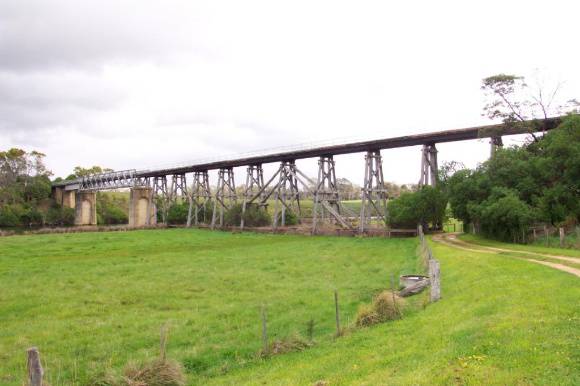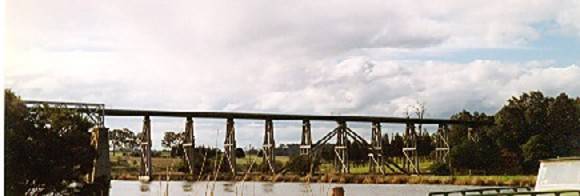| Back to search results » | Back to search page » |
|
Nicholson River Railway Bridge
LocationAdjacent to Princess Highway,, NICHOLSON VIC 3882 - Property No B6946
File NumberB6946LevelState |
|
Statement of Significance
The Nicholson River Railway Bridge is historically, scientifically and aesthetically significant at State level. Built in very difficult years of wartime labour and material shortages, during 1915-1916, it is a substantial single-track sixteen-span composite timber-steel-concrete structure of unique design, with a total deck length of 180 metres and standing at an impressive height above the broad floodplain.
The Nicholson River Bridge is a very complex structure. It combines solid-concrete piers, numerous true timber-trestle piers based on concrete, deeply-driven timber-pile piers, large steel trusses, plate girders, and steel joist spans, and a timber deck. This bridge features very tall and impressive true timber-trestle piers based on concrete, and a unique form of heavy diagonally aligned round timbers used as longitudinal bracing which adds greatly to its visual impact.
The complexity of this bridge's structure was a direct engineering response to site problems. The original river bed was about 500 feet wide, eighty feet below the current flood plain, and composed of unstable black silt. Such soil conditions involved ingenuity in establishing bridge foundations, which varied according to the specific soil situation underlying each bridge pier. The main river-channel span features impressive half-through steel lattice-girders 120 feet long and 12 feet deep, based upon massive concrete piers. An adjacent subsidiary span is composed of plate girders 50 feet long and six feet in depth. Eleven tall and impressive timber-trestle piers carry 28-feet long rolled-steel joists topped by transverse-timber decking originally built from stringy bark and messmate timber. Such a unique combination of structural features in one railway bridge make this a veritable 'museum' of Victorian Railways technology from the period of World War 1, and means that it is potentially of considerable scientific interest.
This large composite structure was a response to one of the most difficult engineering challenges presented by the whole length of line between Bairnsdale and Orbost. Early train traffic to Orbost had been carried by a nearby 'temporary' Nicholson River bridge. Because of its complex structure this bridge was the last component of the railway to be completed, it's opening to traffic occurring many months after the official opening of the railway. More than any other single structure on this historic railway that was built with the intention of carrying train-passengers between Melbourne and Sydney via Bombala, the Nicholson River Bridge symbolizes the engineering response to a massive challenge presented by a developmental-railway project that was described at its official opening as 'the heaviest and most expensive extension of the Victorian Railways system...during the last 23 years'.
The main purpose of the Bairnsdale-Orbost section of the proposed interstate railway was to overcome sand-bar difficulties faced by coastal shipping trying to use Snowy River ports, and in particular to provide reliable all-seasons transport for the heavy maize crops produced on the Snowy River flats. It was also believed that the line would encourage further mineral exploration and exploitation in East Gippsland.
The Nicholson River Railway Bridge is situated in the small township of Nicholson, and traverses a broad and open river floodplain adjacent to a wide section of river that is home to many small leisure craft. Caravan parks and open farmland are nearby. Its position adjacent to and visible from the busy Princes Highway make its fascinating tall and lengthy profile of greater public interest and value. Such a complex and aesthetically pleasing visual experience is not provided by any other bridge in Victoria.
Classified: 19/05/1998
Group
Transport - Rail
Category
Railway Bridge/ Viaduct





